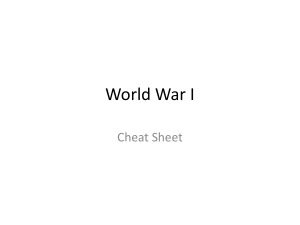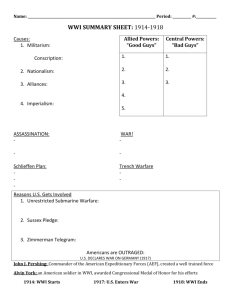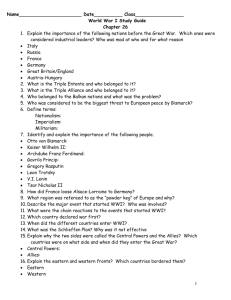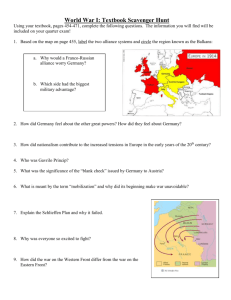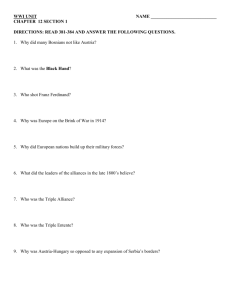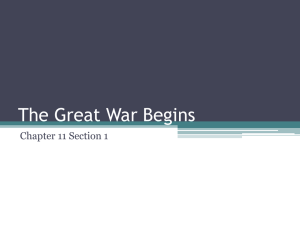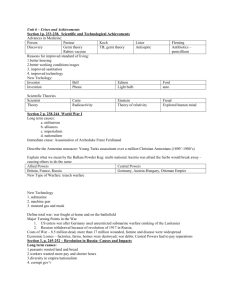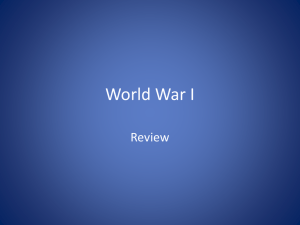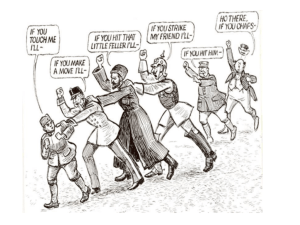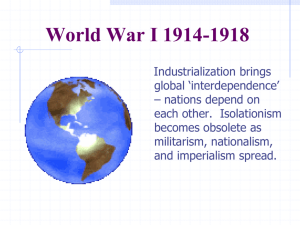World War I
advertisement
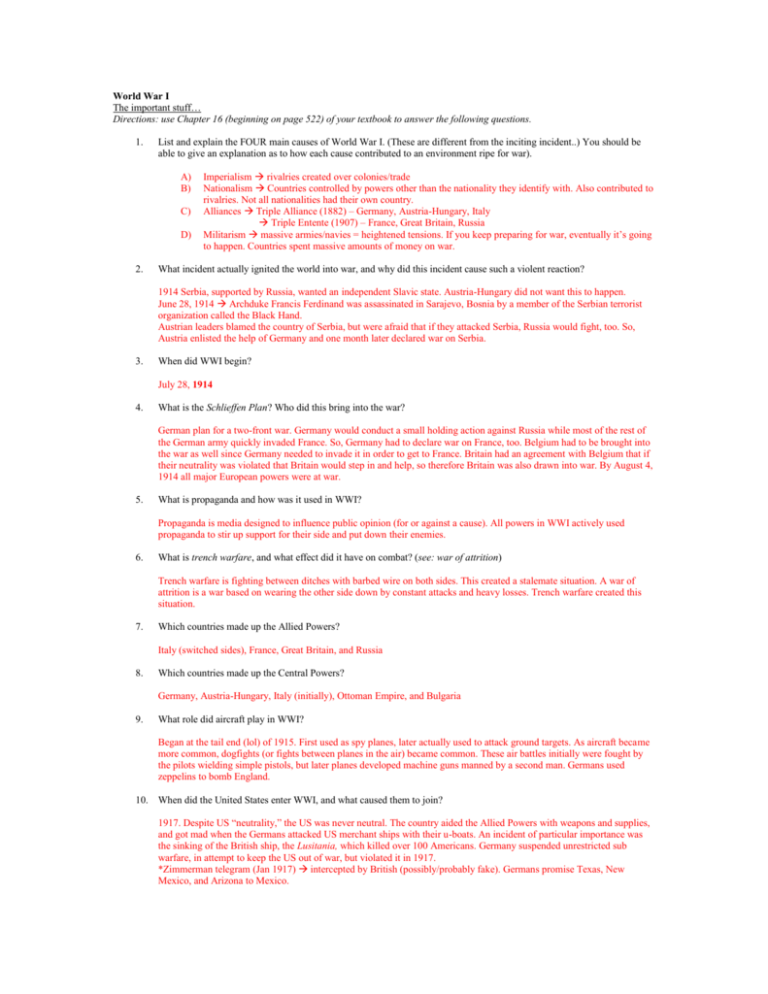
World War I The important stuff… Directions: use Chapter 16 (beginning on page 522) of your textbook to answer the following questions. 1. List and explain the FOUR main causes of World War I. (These are different from the inciting incident..) You should be able to give an explanation as to how each cause contributed to an environment ripe for war). A) B) C) D) 2. Imperialism rivalries created over colonies/trade Nationalism Countries controlled by powers other than the nationality they identify with. Also contributed to rivalries. Not all nationalities had their own country. Alliances Triple Alliance (1882) – Germany, Austria-Hungary, Italy Triple Entente (1907) – France, Great Britain, Russia Militarism massive armies/navies = heightened tensions. If you keep preparing for war, eventually it’s going to happen. Countries spent massive amounts of money on war. What incident actually ignited the world into war, and why did this incident cause such a violent reaction? 1914 Serbia, supported by Russia, wanted an independent Slavic state. Austria-Hungary did not want this to happen. June 28, 1914 Archduke Francis Ferdinand was assassinated in Sarajevo, Bosnia by a member of the Serbian terrorist organization called the Black Hand. Austrian leaders blamed the country of Serbia, but were afraid that if they attacked Serbia, Russia would fight, too. So, Austria enlisted the help of Germany and one month later declared war on Serbia. 3. When did WWI begin? July 28, 1914 4. What is the Schlieffen Plan? Who did this bring into the war? German plan for a two-front war. Germany would conduct a small holding action against Russia while most of the rest of the German army quickly invaded France. So, Germany had to declare war on France, too. Belgium had to be brought into the war as well since Germany needed to invade it in order to get to France. Britain had an agreement with Belgium that if their neutrality was violated that Britain would step in and help, so therefore Britain was also drawn into war. By August 4, 1914 all major European powers were at war. 5. What is propaganda and how was it used in WWI? Propaganda is media designed to influence public opinion (for or against a cause). All powers in WWI actively used propaganda to stir up support for their side and put down their enemies. 6. What is trench warfare, and what effect did it have on combat? (see: war of attrition) Trench warfare is fighting between ditches with barbed wire on both sides. This created a stalemate situation. A war of attrition is a war based on wearing the other side down by constant attacks and heavy losses. Trench warfare created this situation. 7. Which countries made up the Allied Powers? Italy (switched sides), France, Great Britain, and Russia 8. Which countries made up the Central Powers? Germany, Austria-Hungary, Italy (initially), Ottoman Empire, and Bulgaria 9. What role did aircraft play in WWI? Began at the tail end (lol) of 1915. First used as spy planes, later actually used to attack ground targets. As aircraft became more common, dogfights (or fights between planes in the air) became common. These air battles initially were fought by the pilots wielding simple pistols, but later planes developed machine guns manned by a second man. Germans used zeppelins to bomb England. 10. When did the United States enter WWI, and what caused them to join? 1917. Despite US “neutrality,” the US was never neutral. The country aided the Allied Powers with weapons and supplies, and got mad when the Germans attacked US merchant ships with their u-boats. An incident of particular importance was the sinking of the British ship, the Lusitania, which killed over 100 Americans. Germany suspended unrestricted sub warfare, in attempt to keep the US out of war, but violated it in 1917. *Zimmerman telegram (Jan 1917) intercepted by British (possibly/probably fake). Germans promise Texas, New Mexico, and Arizona to Mexico. 11. What is a total war? Complete mobilization of resources and people. Every facet of life is affect—even if you are a civilian. 12. Who was the president of the United States at the time? Woodrow Wilson 13. Who was in control of Russia at the beginning of WWI, and why was this a problem? Czar Nicholas II. He was an idiot. He had no military ability, training, etc., but insisted on directly taking control of the military. Russia didn’t have the military or technology to effectively compete in WWI. Russia suffered heavy losses. 14. What was Grigory Rasputin’s role in the Russian Revolution? Rasputin was a mystic with a lot of influence over Nicholas II’s wife, Alexandra. Rasputin was the real power behind the throne while Nicholas was off being an idiot. There were several assassination attempts on Rasputin’s life, and he was eventually killed in Dec 1916. 15. Who were the Bolsheviks, and what did they want? Small faction of a Marxist party called the Russian Social Democrats. They wanted a violent revolution to destroy capitalism. 16. Who led the Bolsheviks? Lenin 17. What did the Treaty of Brest-Litovsk do? Treaty that ended the war for Russia. Russia gave up eastern Poland, Ukraine, Finland, and the Baltic provinces. Did not establish peace because the Russian Civil War soon followed. 18. What sort of government did Lenin set up? Communist 19. What psychological boost did the Allies get in 1917? The entry of the U.S. into WWI 20. What was Wilson’s peace plan called, and explain some of the key points. Fourteen Points. Advocated for open diplomacy, reducing armaments, self-determination. 21. What year was the Paris Peace Conference? 1919 22. Who were the Big Four? Woodrow Wilson (US), David Lloyd George (UK), Georges Clemenceau (France), Italy 23. What treaty ended WWI? Treaty of Versailles 24. What did the War Guilt Clause stipulate? Germany had to take the blame for WWI. They had to pay reparations, reduce military drastically, lost Alsace and Lorraine, lost east Germany to new Polish state, demilitarized Rhine
